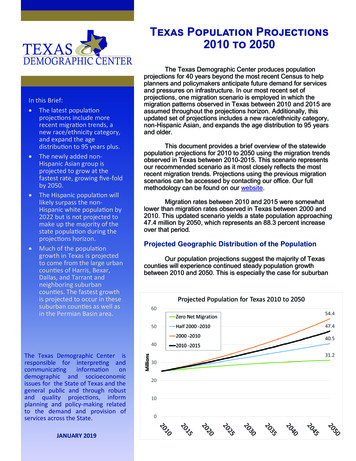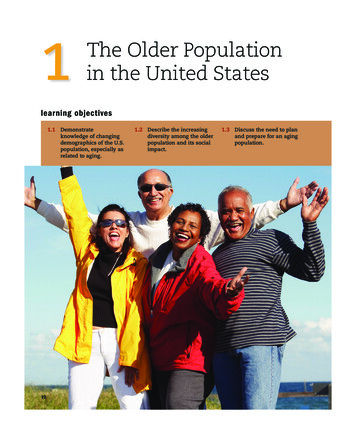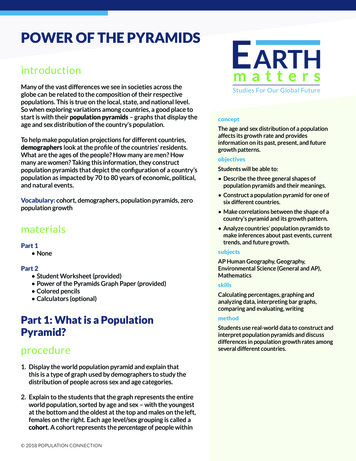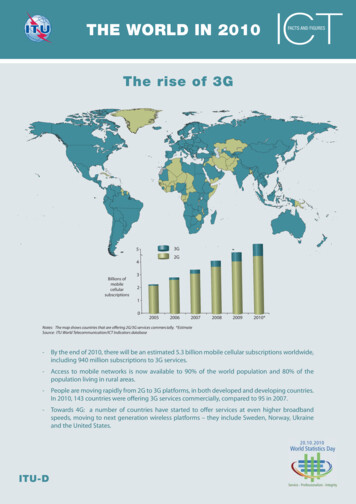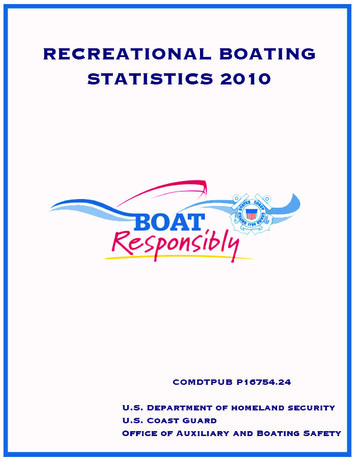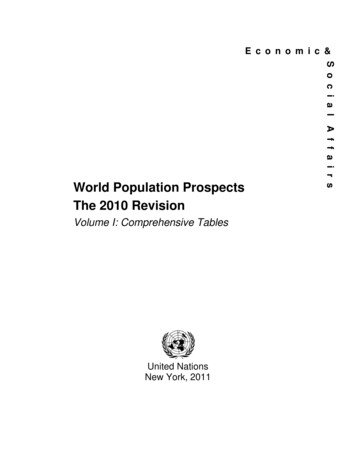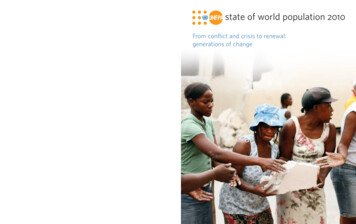
Transcription
state of world population 2010From conflict and crisis to renewal: generations of changeUnited Nations Population Fund605 Third AvenueNew York, NY 10158 USAwww.unfpa.orgUSD 17.50ISBN 978-0-89714-974-7sales no. E.10.III.H.1E/20,000/2010Printed on recycled paper.state of world population 2010From conflict and crisis to renewal:generations of change
Editorial teamThe State of World Population 2010This report was produced by the Information andExternal Relations Division of UNFPA, the United NationsPopulation Fund.Reported and written by Barbara CrossetteUNFPA Advisory Board: Upala Devi, Laura Laski, JemilahMahmood, Aminata Toure, Sylvia WongTechnical adviser: Nata DuvvuryEditor: Richard KollodgeEditorial associates: Phyllis Brachman, Robert PuchalikEditorial and administrative associate: Mirey ChaljubAcknowledgementsThe editorial team is especially grateful to the report’s AdvisoryBoard for guiding the conceptualization and development of thereport and for providing invaluable feedback on drafts.Nata Duvvury, Lecturer, Global Women’s Studies, at theNational University of Ireland, Galway, led research for theproject, ensured that the report reflected current thinkingon women, peace and security and also reviewed drafts anddeveloped the report’s annotated bibliography.Heads or acting chiefs of seven UNFPA’s field offices (and theirstaff) set up interviews, arranged logistics and helped guidethe reporting in each location: Esperance Fundira (Monrovia),Faris Hadrović (Sarajevo), Muna Idris (Amman), Janet Jackson(Kampala), Barbara Laurençeau (Port-au-Prince), BarbaraPiazza-Georgi (Jerusalem) and Pornchai Suchitta (Dili). UNFPA’sregional directors provided valuable support to the developmentof the report: Hafedh Chekir (Arab States), Thea Fierens(Eastern Europe and Central Asia), Nobuko Horibe (Asia),Bunmi Makinwa (Africa) and Marcela Suazo (Latin Americaand the Caribbean).Invaluable insights were also provided by Safiye Çağar, Directorof the Information and External Relations Division; Neil Ford,Chief of the Media and Communications Branch; and AnnErb-Leoncavallo, Bettina Maas and Sherin Saadallah of UNFPA’sOffice of the Executive Director.The VII Photo Agency mobilized photojournalists to three ofthe countries featured in this report: Bosnia and Herzegovina(Antonin Kratochvil), Liberia (Marcus Bleasdale) andTimor-Leste (Ron Haviv).The indicators in the report were generously contributed bythe Population Division of the United Nations Department ofEconomic and Social Affairs, UNESCO Institute for Statistics,the World Health Organization, the Food and AgricultureOrganization of the United Nations, the World Bank and theUNFPA/NIDI Resource Flows Project. Edilberto Loiaza ofUNFPA’s Population and Development Branch contributed theanalysis of indicators related to Millennium Development Goal 5.The editorial team also wishes to thank the individuals whocourageously told their stories for this report.Cover photo:Women clearing rubble from the streets ofPort-au-Prince, Haiti. UN Photo/Sophia ParisUNFPA, the United Nations Population Fund, is an international development agency thatpromotes the right of every woman, man and child to enjoy a life of health and equalopportunity. UNFPA supports countries in using population data for policies and programmesto reduce poverty and to ensure that every pregnancy is wanted, every birth is safe, everyyoung person is free of HIV, and every girl and woman is treated with dignity and respect.UNFPA—because everyone counts.
state of world population 2010From conflict and crisis to renewal:generations of changeForewordpage iiAbout this reportpage 11Bosnia and Herzegovinaas catalyst of changepage 75Youth: The future ofpost-conflict societiespage 472A resolution and reality:a decade on the groundpage 156Living without an anchor:refugees and the internally displacedpage 633Women on the frontlines of recoverypage 277Imprisoned at home:life under occupationpage 714In times of crisis, genderrelations in fluxpage 398And the nextten years?page 77Bibliographypage 86Indicatorspage 92Copyright UNFPA 2010United Nations Population FundThoraya Ahmed Obaid, Executive DirectorPhoto: Benjamin Lowy/VII Network
ForewordWomen rarely wage war, but they too often suffer the worst of its consequences.Gender-based violence, including rape, is a repugnant and increasingly familiar weaponof war. The immediate toll it takes extends far beyond its direct victims, insidiouslytearing apart families and shattering societies for generations to come.Conflict today is less about soldiers engaging in battle with soldiers on the other side ofa national border and more about combatantsstruggling for control within a single countryand employing any means to break the will ofcivilians—women, girls, men and boys—bydisempowering them physically, psychologically, economically, and socially.In many of today’s conflicts, women aredisempowered by rape or the threat of it, andby the HIV infection, trauma and disabilitiesthat often result from it. Girls are disempowered when they cannot go to school because ofthe threat of violence, when they are abductedor trafficked, or when their families disintegrate or must flee. In some conflicts, men arealso disempowered by sexual violence. Boys,too, are sometimes exploited or forced tobecome soldiers.The State of World Population 2010 exploreshow conflict and protracted humanitarianemergencies affect women and girls—and menand boys—and shows how many women andyoung people have overcome seemingly insurmountable obstacles and have begun rebuildingtheir lives and laying the foundation for peaceand renewal of their societies.UNFPA, the United Nations PopulationFund, is a development agency that promotesthe right of every woman, man and child toenjoy a life of health and equal opportunityand that ensures every pregnancy is wanted,iiFORE WORDevery birth is safe, every young person is free ofHIV and AIDS and every girl and woman istreated with dignity and respect. As this reportshows, UNFPA supports governments’ effortsto empower women and girls—and men andboys—not only those who have been disempowered by conflict, but also those affected bydisasters, such as the earthquake that struckHaiti in January 2010. UNFPA also supportscivil society organizations, which are essential tothe healing process of any community.While the earthquake in Haiti has garnered extensive media coverage, the crisis inKyrgyzstan has not, even though the latterresulted in the loss of hundreds of lives and thedisruption of tens of thousands more. Yet, inboth places, women and youth are facing internal displacement or refugee situations, and theirsituations are precarious because they cannotaccess reproductive health care and are morevulnerable to gender-based violence.This report coincides with the 10th anniversary of Security Council resolution 1325,which called on parties to armed conflicts totake measures to protect women and girls fromgender-based violence and called for greaterinvolvement by women in negotiating andimplementing peace agreements. But this reportis not only about the resolution. It is also aboutthe special challenges women face in conflict orin humanitarian emergencies and about howwomen themselves are responding, healing
twounds, moving forward, and not just helpingthe communities return to the status quo butalso building new nations on foundations ofequal rights and opportunities.Resolutions may guide governments’and the international community’s responseto conflict and establish the framework foractions to protect women and assure their participation in peacebuilding and reconciliation,but they are not a substitute for grassrootsefforts to empower women and to build longterm resilience to crises of any sort, whetherwar, an earthquake or any other catastrophe.Governments need to seize opportunitiesarising out of post-conflict recovery or emerging from natural disasters to increase thechances that countries are not just rebuilt, butbuilt back better, and renewed, with womenand men on equal footing, with rights andopportunities for all and a foundation fordevelopment in the long run.Experience over the past decade underscores the need to tear down the false barriersbetween crisis, recovery and development.After war or disaster, the humanitarianresponse must include actions that will sow theseeds for long-term development and peace, sothat countries will be better equipped to prevent future outbreaks of violence and to restorenormalcy sooner after a catastrophe like theearthquake in Haiti. We must replace a viciouscycle of crisis and underdevelopment with avirtuous one of social and economic progressand empowerment.The continuum between development andcrisis and vice versa makes it clear that whateveris invested in development softens the impactof crisis and natural disaster. The relationshipbecomes apparent when we compare the impactof recent earthquakes in Haiti and Chile. ButUNFPA ExecutiveDirector meetsHaitian youth trackingmalnutrition amongmothers and childrenthrough the GheskioCentre in Port-au-Princein March 2010. UNFPA/Vario Serantit is also true that whatever is invested duringthe humanitarian response phase can become asolid foundation for rebuilding a society. Thiscontinuum moves in both directions.Experience also shows that gender-basedviolence does not occur in a vacuum. It is usually a symptom of a larger problem, one offailed institutions, of norms that perpetuate ortolerate abuse, of dangerously skewed genderrelations and entrenched inequalities. War anddisaster do not cause gender-based violence,but they often exacerbate it or allow it tostrike with greater frequency.Finally, the nature of the internationalcommunity’s response to conflict is changing,with fewer resources devoted to traditionalpeacekeeping operations and more to development-oriented interventions that lay thefoundation for governments to protect civilians from harm and enable them to prosper inthe long run. But while governments have theofficial responsibility to protect their people,communities and individuals must also playa role in promoting peace and security. Whenall stakeholders are involved, a recoveringsociety is less likely to relapse into chaos andterror after peacekeepers return home.Thoraya Ahmed ObaidExecutive Director, UNFPAT H E STAT E OF WORL D POPU L AT ION 20 1 0iii
ivAB OUT THI S RE PORT
About this reportTen years ago, on 31 October 2000, the United Nations Security Council tookan important and unprecedented step into new territory. Recognizing the vulnerability of women and girls to violence during and after armed conflict, and theabsence or low level of women’s representation in efforts to prevent war, buildpeace and restore devastated societies, the Council passed resolution 1325. Theresolution sought formally for the first time in the Security Council to end thistLiberian womendemonstrate in Monrovia,Liberia, at the height ofthe civil war in 2003.Image from the film, Praythe Devil Back to Hell. Pewee Flomukoneglect and actively to promote and drawon the untapped potential of women everywhere on issues of peace and security.The release of the 2010 edition of TheState of World Population report coincideswith the 10th anniversary of that historicresolution. The report highlights how womenin conflict and post-conflict situations—aswell as in emergencies or protracted crises—are faring a decade later.The 2010 report is different from previous editions, which took an academicapproach to topics related to the mandateand work of UNFPA, the United NationsPopulation Fund. The current report takesa more journalistic approach, drawing onthe experiences of women and girls, menand boys, living in the wake of conflict andother catastrophic disruptions. They speakfor themselves about the challenges theyface, the ways their communities are coping and becoming more resilient and abouthow many of them have become involved inreconstruction and renewal. The individualsfeatured in the report are neither statisticiansnor demographers. They are rural peopleliving off the land and urbanites trying tosurvive in broken cities. Many survivors ofconflict and natural disasters are now working in their communities to help fellowcitizens recover and readjust.Globally, there is a growing roster ofnon-governmental organizations and community activists working in partnershipwith governments, United Nations agencies,donor countries and foundations. In themix are also traditional elders and religiousleaders who strive to comfort the sufferingand bring decimated societies back to theircultural roots and principles, so often warpedby war, refugee flight, occupation and naturaldisasters. Local initiatives are healing woundswhile rethinking old habits and rules ofbehaviour for a new age.While the Security Council was passingresolution 1325 in 2000 and several otherson the protection of women in the years thatfollowed, activities were already taking placeon the ground in countries where victimsof conflict and disaster were frequently noteven aware they had moved into the SecurityCouncil’s spotlight. They just knew fromT H E STAT E OF WORL D POPU L AT ION 201 01
United Nations Security Council resolutions on women, peace and securityResolution 1325 (2000), on women,Re s o l u t i o n 1 8 8 8 ( 2 0 0 9 ) wa s ademobilization and reintegration andpeace and security, was the first tofollow-up resolution to resolution 1820,security-sector reform.address the impact of conflict onemphasizing the importance both ofwomen during and in the aftermath ofaddressing issues of sexual violenceResolution 1889 (2009) reaffirmed thearmed conflicts. The resolution calledfrom the very outset of a peace processSecurity Council’s commitment to theon all parties to an armed conflict toand of bringing perpetrators to justice.continuing and full implementation, in atake special measures to protectThe resolution called for the inclusionmutually reinforcing manner, of resolu-women and girls from gender-basedof specific provisions for the protectiontions 1325, 1820 and 1888, as well asviolence, particularly rape and otherof women and children in the mandatesrelated resolutions: 1612 (2005), 1674forms of sexual abuse.of United Nations peacekeeping opera-(2006), and 1882 (2009). The Counciltions and United Nations-sponsoredexpressed its continued deep concernResolution 1820 (2008) was the firstpeace negotiations. The Securityabout the persistent obstacles to wom-to exclusively address sexual violenceCouncil emphasized the importanceen’s full involvement in the preventionin armed conflicts. The resolutionof addressing sexual violence issuesand resolution of conflicts and theirrecognized sexual violence as a secu-from the outset of peace processes andparticipation in post-conflict public life.rity issue, noting that the perpetrationmediation efforts, to protect popula-It recognized that the marginalizationof sexual violence as a tactic of wartions at risk and promote full stability,of women can delay or undermine theagainst civilians was a threat to theparticularly in the areas of pre-ceasefireachievement of durable peace, securitymaintenance of international peacehumanitarian access and human rightsand reconciliation.and security.agreements, ceasefires, disarmament,Assistant Commissionert1Bennetta Holder Warner,in the women and childrenprotection centre of theLiberian National Police. VII Photo/Marcus Bleasdale2AB OUT THI S RE PORT
experience that there was a lot of rebuildingto be done, and they started undertaking it,head on, often with help from United Nationsagencies, funds and programmes and humanitarian organizations.This report is constructed aroundinterviews and reporting in Bosnia andHerzegovina, Haiti, Jordan, Liberia, theOccupied Palestinian Territory (West Bank),Timor-Leste and Uganda. The diverse nationswere chosen for various reasons. Some haverecently emerged from conflict and arerebuilding with limited resources. Some haveexperienced profound social changes as aresult of war and displacement. All have aUnited Nations presence, in some cases anintegrated peacekeeping mission, but everywhere an active group of United Nationsagencies supporting both governmental andnon-governmental efforts. Liberia and Ugandaare living in the aftermath of recent conflicts.Stories from the West Bank illustrate the particular issues created by occupation. In Jordan,Iraqi refugees talk about their uprooted lives.Bosnia and Herzegovina demonstrates howlong it can take to heal the victims of war,2and how communities can help or hinder theprocess. In Haiti an impoverished populationalready worn down by decades of unrest nowhas to rebuild a nation after a cataclysmicearthquake, which came on the heels of twodevastating hurricanes.Working at the grassroots level, community organizations—some barely a fewpersons strong—and larger non-governmentalorganizations have already broadened themeaning of Security Council resolutions andUnited Nations declarations. What began asa call on governments a decade ago to dealwith abuses or neglect of women and girls hassteadily grown into a broader movement thatencompasses all members of society. Today,for example, more attention is being paidto the psychological and physical wounds ofmen and boys, who, people in very differentcountries now agree, must be part of rebuilding societies and lives and creating space forfostering peace.Psychosocial counselling for victims oftrauma is expanding exponentially and becoming more professional in many places. Theneeds of wounded communities are definedUn WOMENThe United Nations General Assembly“UN Women will significantly boost International Research and Trainingvoted unanimously on 2 July 2010 toUnited Nations efforts to promoteInstitute for the Advancement ofestablish a new entity to accelerate prog-gender equality, expand opportunity,ress in meeting the needs of women andand tackle discrimination around the Office of the Special Adviser ongirls worldwide. The establishment of theglobe,” said Secretary-General BanGender Issues and the AdvancementUnited Nations Entity for Gender EqualityKi-moon.of Women;and the Empowerment of Women—toUN Women will build on the workbe known as UN Women—is part of theof four previously distinct parts of theUnited Nations reform agenda, bringingUnited Nations system:together resources and mandates for Division for the Advancement ofgreater impact.Women;Women; United Nations Development Fundfor Women (UNIFEM).UN Women will begin operationsin January 2011.T H E STAT E OF WORL D POPU L AT ION 20 1 03
3Transforming resolutions into realityUNPFA, in partnership with many1325. UNFPA and partner organiza-In Liberia, UNFPA supported thestakeholders, is helping countries andtions have also conducted training forMinistry of Justice’s establishment ofterritories transform resolution 1325—women members of the Constituenta sexual and gender-based violenceand subsequent ones that also dealAssembly in 2008 on basic humanprosecution unit, with a 24-hour-a-with women, peace and security—intorights, with an emphasis on Securityday hotline and a court that dealsreality. Much of UNFPA’s work at theCouncil resolutions 1325 and 1820.exclusively with cases of gender-basedcountry level focuses on developingIn Tajikistan, UNFPA collaborates withthe capacities of governments, Uniteda committee of non-governmental orga-Nations agencies and institutions tonizations that combat violence againstincorporate gender issues in the designwomen under the Convention on theand implementation of activities in theElimination of All Forms of Discriminationrealm of peace and security, preven-Against Women.tion, protection and participation.ProtectionPreventionWomen’s participationIn Colombia, UNFPA’s humanitarianstrategy includes a component related to the participation of women indecision-making processes related tohumanitarian situations. UNFPA is alsoIn Botswana, UNFPA supported andsupporting women’s organizations toIn Colombia, UNFPA created a taskprovided sexual and reproductiveparticipate in the peace process.force to mainstream gender issues andhealth services, including HIV preven-sensitize the armed forces and policetion, to a clinic serving refugees.In Botswana, UNFPA, in partnership with the local state universityIn Colombia, UNFPA is supportingand UNICEF, initiated a programmeIn Georgia, UNFPA provides train-projects that develop the capacity ofto develop capacities of the Houseing to service providers on issuesinstitutions and communities to expandof Chiefs in Parliament to holistical-related to reproductive health, sexualintegrated protection systems relatedly address issues related to women,and gender-based violence and clinicalto violence against women.peace and security.to issues of gender-based violence.management of rape survivors.In Kosovo, UNFPA supports psychosocial training for staff of the MinistryIn Côte d’Ivoire, UNFPA has createdIn Rwanda, UNFPA is supportingcentres to provide services to survivorsthe National Police to more effectivelyof gender-based violence.address gender-based violence andof Health and the Kosovo Women’sIn Indonesia, UNFPA supportedNetwork of non-governmental orga-the Aceh provincial planning andnizations that advocate for genderdevelopment agency in drafting a pro-equality and women’s empowermentvincial action plan to address issues ofand for the prevention and eliminationwomen, peace and security.of gender-based violence.In Kosovo, UNFPA and the MinistryIn Liberia, UNFPA supported theof Labour and Social Welfare are col-Ministry of Health and Social Welfare’slaborating on a funding strategy forestablishment of psychosocial and com-shelters for women victims of domes-munity support services, especially fortic violence.survivors of sexual and gender-basedviolence.4violence.In Lebanon, UNFPA is helping develop the capacity of service providers forIn Nepal, UNFPA is supporting theensuring quality mental, psychosocialdevelopment of a National Action Planand reproductive health services tofor the Implementation of resolutionwomen in post-conflict communities.AB OUT THI S RE PORTpromote recruitment and promotion ofwomen within their ranks.
those who have lost their homes as a resultof natural disaster. It is now recognized thatgender roles can be upset and transformed bywar, military occupation and refugee life, allof which can lead to changed economic relationships within households. Such changescan have profound social effects, and theopportunity to fathom them and put theknowledge to constructive use is a bellwetherof the post-conflict world. In countless smalland large ways, in many countries where lifehas been disrupted, people, often with support from humanitarian and developmentorganizations, are working in many waysto make the future better.tnot only in terms of peace agreements andthe cessation of violence after conflict butalso in informal and formal programmesthat dig deep into history, politics, economics and culture to try to explain why violencehappened—or continues after conflicts end—and what to do to root out the causes. Theimportance of bringing young people intothese discussions is widely accepted and manynovel programmes have begun in recent years.Artists of all kinds and of all ages are eager tojoin in the discussion through their work, asare sports personalities who volunteer to workwith youth.Echoing the spirit of the 2005 UnitedNations General Assembly’s World Summit,even if unintentionally, many citizens are taking heed of governments’ “responsibility toprotect” their people. Nations of the worldagreed in 2005 to assign to governments firstand foremost the burden of shielding theircitizens from harm on a mass scale, with theinternational community standing by to helpor take action to stop abuse if all else fails. Theresponsibility to protect has been interpretedwidely. Apart from ensuring against physicalharm, in some places it is seen as covering,at least in spirit, such steps as creating orstrengthening legal and judicial institutionsnecessary in post-conflict areas, where property rights are frequently in dispute or there isunsettling violence in homes or crime in thestreets. Functioning institutions of all kinds,including health and educational services,hasten a return to normality and can helpprevent future conflict.Gender-based violence and abuse continues in many forms, often exacerbatedby armed conflict or the destabilization offamily life in camps for the displaced or forDubravka SalčićDizdarević, a physicianat the NationalUniversity Hospitalin Sarajevo andone of Bosnia andHerzegovina’s leadingpsychotherapists.“Torture also has theaim of victimizing thewhole family.” VII Photo/AntoninKratochvilT H E STAT E OF WORL D POPU L AT ION 201 05
6CHAP T ER 1 : B osnia and Her zegovina as catalyst for change
CHAPTERONEBosnia andHerzegovina ascatalyst for changeThe woman in Mostar, in late middle age, moved apprehensively into thewindowless room where she had agreed to talk, early in 2010, about a liferuined by war and never repaired. In the complex web of ethnic conflict, herBosnian Serb husband was shot in 1992 for refusing to wear the uniform of Serbforces. It was only five years ago that she was finally able to confirm her husband’smurder, based on DNA evidence. A Croat, she had been caught between warringtBosnian woman infront of a burned downindustrial complexthat was used as aconcentration campduring the war. VII Photo/Antonin KratochvilSerbs and Bosniaks. For terrifying days andweeks after her husband was taken away—andshe was also threatened with death—she wentfrom office to office, soldier to soldier, in theever-dimming hope of finding him. She couldnot eat, although there was food. She could notrest. She had to hide—one night in a neighbor’scoal bin—just in case they came for her.When she could, she went home. Her facesuddenly contorts in anguish: “After a time,we had no running water and I had to go tothe cistern,” she said. “On the way back, I wasintercepted by three soldiers,” she said. “Theytold me to put down the water and followthem.” Her story turns to a tale of unremitting horror as she recalls the hours of sexualviolence that followed. “They tortured me;they did unimaginable things,” she said. “Ibegged them to kill me.”It was atrocities like this in Bosnia andHerzegovina, and then in Rwanda and WestAfrica in the 1990s that prompted the international community to label such brutalexperiences “war crimes,” first in regionaltribunals and then in the 1998 Rome Statutethat created the International CriminalCourt. It was crimes such as these that alsoled in the first decade of this century—when the world’s focus had turned to theeastern Democratic Republic of Congo andDarfur—to repeated debates in the UnitedNations Security Council. The brutalities ofthe 1990s were the starting point on the roadthat led to resolution 1325 and several otherresolutions that followed.The woman in Mostar was 50 years old atthe time she was abused. It was not until 2006,still suffering kidney damage and high bloodpressure, that she was able to talk about thatday with another rape survivor, who, she said,would understand. “I could not share my storyuntil then,” she said. “I was afraid I would beT he STAT E OF WORL D POPU L AT ION 201 07
Enisa Salčinović(right), president ofthe Association ofConcentration CampTorture Survivors inBosnia and Herzegovina.Of the 2,000-plusmembers of herassociation, a quarterof them were raped.t8 VII Photo/AntoninKratochvilblamed. The stigma was too great.” Her twosons, living abroad, have never been told. Thetragic life of this woman, now in her late sixtiesand still in psychotherapy, demonstrates howlong the scars of war go on in the minds andsouls of victims. Her story and many othersalso show how much remains to be done bythe international community, governments andcivil society to spare future generations aroundthe world from this brutality.Nearly two decades have passed sinceBosnia and Herzegovina was consumed bythe most costly war in Europe, in terms ofhuman life, in more than half a century. Thecountry’s capital, Sarajevo, was under siegefor four long years. It has been 15 years sincea peace agreement ended the fighting. Butin cities as different and scattered as Mostar,Tuzla and Sarajevo, women who survived “rapeCHAP T ER 1 : B osnia and Her zegovina as catalyst for changecamps” and sexual assault in their homes andneighborhoods still live in shame and fear, psychologically broken and long denied the dignityand reparations they seek. They come to meet astranger, confident that they will be able to telltheir stories, but mostly they cannot. Controlbreaks down, cigarettes are lit, trembling begins,voices crack and the sobbing starts.Though there are occasional stories ofneighbors helping neighbors, women inBosnia and Herzegovina often say that theyhave been pained by the lack of communitysupport to help them through their mostterrible hours. When many returned home,they were abandoned and cursed by relativesand erstwhile friends. They are still shakento remember that men who had also survived detention, humiliation and torture, orwho had narrowly escaped death, somehowcould not find in themselves understandingand sympathy for women, who were insteadaccused of dishonouring their families. Manywomen began to feel guilty, they say. Theysank into secret shame, suppressing theirstories, often for years.The war in Bosnia and Herzegovinakilled, it is estimated, at least 100,000people, and about 12,500 are still missing.There were atrocities on all sides in this warand others that followed the breakup of theformer Yugoslavia.In some Bosniak communities, for example, women were separated from men anddetained for periods of time in any place thatcould be turned into a makeshift detentioncentre. They were taken out one, or a few, at atime to be sexually abused. Those who esca
state of world population 2010 state of world population 2010 From conflict and crisis to renewal: generations of change United Nations Population Fund 605 Third Avenue New York, NY 10158 USA www.unfpa.org USD 17.50 ISBN 978--89714-974-7 sales no. E.10.III.H.1 Printed on recycled paper. From conflict and crisis to renewal: generations of change
